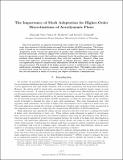The Importance of Mesh Adaptation for Higher-Order Discretizations of Aerodynamic Flows
Author(s)
Yano, Masayuki; Modisette, James; Darmofal, David L.
DownloadDarmofal_The importance.pdf (6.000Mb)
OPEN_ACCESS_POLICY
Open Access Policy
Creative Commons Attribution-Noncommercial-Share Alike
Terms of use
Metadata
Show full item recordAbstract
This work presents an adaptive framework for a higher-order discretization of the Reynolds-averaged Navier-Stokes (RANS) equations. The adaptation strategy is based on an output-based error estimate and explicit control of the degrees of freedom. Adaptation iterates toward the generation of simplex meshes that equidistribute local errors throughout the domain and provide anisotropic resolution in arbitrary orientations. Numerical experiments reveal that uniform refinement limits the performance of higher-order methods when applied to aerodynamic flows with low regularity. However, when combined with anisotropic refinement of singular features, higher-order methods can significantly improve computational affordability of RANS simulations in the engineering environment. The benefit of the higher spatial accuracy is exhibited for a wide range of applications including subsonic, transonic, and supersonic flows. The higher-order simplex meshes are generated using the elasticity and the cut-cell techniques, and the competitiveness of the cut-cell method is demonstrated in terms of accuracy per degree of freedom.
Date issued
2011-06Department
Massachusetts Institute of Technology. Aerospace Computational Design Laboratory; Massachusetts Institute of Technology. Department of Aeronautics and Astronautics; Massachusetts Institute of Technology. Department of Mechanical EngineeringJournal
Proceedings of the 20th AIAA Computational Fluid Dynamics Conference
Publisher
American Institute of Aeronautics and Astronautics
Citation
Yano, Masayuki, James Modisette, and David Darmofal. “The Importance of Mesh Adaptation for Higher-Order Discretizations of Aerodynamic Flows.” 20th AIAA Computational Fluid Dynamics Conference (June 27, 2011).
Version: Author's final manuscript
ISBN
978-1-62410-148-9